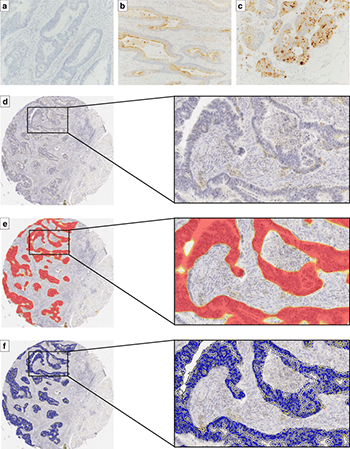Prognostic significance of mesothelin expression in colorectal cancer disclosed by area-specific four-point tissue microarrays
Mesothelin (MSLN) is a cell surface glycoprotein present in many cancer types. Its expression is generally associated with an unfavorable prognosis. This study examined the prognostic significance of MSLN expression in different areas of individual colorectal cancers (CRCs) using tissue microarrays (TMAs) by enrolling 314 patients with stage II (T3–T4, N0, M0) CRCs. Using formalin-fixed paraffin-embedded tissue blocks from patients, TMA blocks were constructed. Tissue core specimens were obtained from submucosal invasive front (Fr-sm), subserosal invasive front (Fr-ss), central area (Ce), and rolled edge (Ro) of each tumor. Using these four-point TMA sets, MSLN expression was immunohistochemically surveyed. The area-specific prognostic significance of MSLN expression was evaluated. A deep learning convolutional neural network algorithm was used for imaging analysis and evaluating our judgment’s objectivity. MSLN staining ratio was positively correlated between the manual and machine-learning analyses (r = 0.71). The correlation coefficient between Ro and Ce, Ro and Fr-sm, and Ro and Fr-ss was r = 0.63, r = 0.54, and r = 0.61, respectively. Disease-specific survival curves for the MSLN-positive and MSLN-negative groups in Fr-sm, Fr-ss, and Ro were significantly different (five-year survival rates 88.1% and 95.5% (P = 0.024), 85.0 and 96.2% (P = 0.0087), 87.8 and 95.5% (P = 0.051), and 77.9 and 95.8% (P = 0.046) for Fr-sm, Fr-ss, Ce, and Ro, respectively). The analysis performed using area-specific four-point TMAs clearly demonstrated that MSLN expression in stage II CRC was relatively homogeneous within tumors. Additionally, high MSLN expression showed or tended to show unfavorable prognostic significance regardless of the tumor area.
Takehiro Shiraishi, Eiji Shinto, Ines P. Nearchou, Hitoshi Tsuda, Yoshiki Kajiwara, Takahiro Einama, Peter D. Caie, Yoji Kishi & Hideki Ueno
Virchows Archiv | February 2020 | DOI: 10.1007/s00428-020-02775-y
